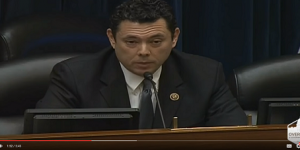nytimes —
TIJUANA, Mexico — After more than a month on the move, a caravan of migrants from Central America has come to a halt just a few yards from the border wall that divides Mexico and the United States.
The metal barrier looms near the sports center where Tijuana’s city government has set up a shelter for the migrants, whose numbers are swelling as buses arrive almost daily. On the other side — beyond floodlights, motion sensors, cameras and a second fence — lies their goal: the United States.
But it is dawning on many of them that the shelter could be their home for months if they decide to seek legal entry into the United States.
“We have to wait — for how long?” asked Lenin Herrera Batres, 20, who joined the caravan with his wife and their 2-year-old son to escape threats after the couple witnessed a murder in the Honduran city of San Pedro Sula.
“We don’t have the money to stay here for one month, two months,” he said, his voice trailing off.
Less than a week old, the shelter has assumed the squalor of an overwhelmed refugee camp, and the rhythms of enforced idleness have taken hold. One group spends hours watching karaoke singers at an end of the basketball courts there, while men bet on cards at the other. Children dart around a playground. Women fold donated blankets in the reflexive gestures of tidying up at home, now just a tiny patch under a large tent.
City officials, who fear that as many as 10,000 migrants from this caravan and two more behind it may ultimately alight in Tijuana in the coming weeks, are scrambling to provide for them.
“I sleep only three hours a night, and when I close my eyes I count migrants, not sheep,” said César Palencia Chávez, the director of migrant services for Tijuana. “No city can be prepared for the arrival of 5,000 people over three to four days. We are doing what’s humanely possible.”
The number of migrants at the shelter swelled to almost 2,500 this weekend, with room for only 1,000 more.
But an estimated 3,400 are waiting in Mexicali, a border city two and half hours to the east, and most of those are expected to reach Tijuana on Monday, said Maggie Núñez, who was working with Pueblo sin Fronteras, an advocacy group that is assisting the caravan.
Tijuana’s mayor, Juan Manuel Gastélum, has estimated that if all of the Central American migrants traveling north come to the city and seek asylum in the United States, it could take six months for their claims to be heard at the main port of entry to San Diego.
They must take their turn behind about 3,000 others — from Mexico, nations across Central and South America, and even West Africa — who are waiting for an interview with a United States asylum officer. The delay may last as long as two months.
New rules issued by the Trump administration this month are designed to funnel asylum seekers to an official port of entry rather than allowing them to present themselves to the Border Patrol if they make it across the border illegally.
As the bottleneck in Tijuana has grown, it has threatened to try the patience of a city that is itself the creation of migrants and typically provides for them through church-run shelters.
Some Mexicans ask why Central Americans are receiving special treatment, when the government offers no help for Mexicans fleeing violence in other states or for those deported from the United States.
“There are so many undocumented people who do not have Mexico’s help,” said Rosa Guadalupe Martínez, 61, an optometric technician, who on Sunday joined a protest march of several dozen people waving Mexican flags. Others were openly hostile, alleging that some of the Central Americans would turn to crime.
It is impossible to square the listless mood of the shelter with what President Trump railed against as a caravan “invasion” before this month’s midterm elections.
By banding together, the migrants sought protection against the criminal gangs and corrupt officials who prey on people trying to reach the United States border. But they had little sense of the political firestorm their trek had set off.
Many of the migrants repeat the magical thinking that has sustained them through their journey and brought them right up to the edge of the border: a belief that once all of the caravan has reached Tijuana, the gates may by flung open.
“God wants Trump’s heart to be touched,” said Francisco Naum, 27, who was traveling from Honduras with relatives. “If God gave us the possibility to get all the way here, he will continue to open doors.”
Others have begun to deal in practicalities, walking a mile from the shelter to enter their names on a waiting list for an asylum interview. Some clustered around volunteer American lawyers who arrived at the shelter to explain the basics of asylum law.
“People don’t flee their country and go through the arduous trip on foot unless the situation is desperate,” said Gilbert Saucedo, a Los Angeles lawyer who helped organize the volunteers through the National Lawyers Guild.
“I have talked to maybe 100 people today,” he said on Saturday, “and maybe 70 percent had credible cases on the surface.” Yet many lack the documents they need to provide evidence.
The migrants often reveal little emotion when recounting the violence they have fled, as if admitting grief could lead to a despair that would paralyze them at the very moment they need to keep pressing ahead.
“They killed my whole family, my father, my mother and my two brothers,” said Jose Miguel Martínez, a rail-thin 18-year-old from El Salvador. He said he had been spared because he was in the military at the time — but never received a police report or death certificate.
Orbelina Meléndez, 36, watched as her husband was shot in front of her in Tegucigalpa, the Honduran capital, and then received death threats. She has no police report. “When you are poor, they do not investigate and it remains unpunished,” she said.
Dr. Allen Keller, the director of the Bellevue/N.Y.U. Program for Survivors of Torture, who has flown to Mexico to meet with caravan members, called the situation “a refugee crisis.”
“These individuals are not here by choice,” he said. “In fact, they believe they have no choice.”
Melissa Guzmán, 33, from Honduras, was one of those who turned up early Saturday to put her name on the interview waiting list. She had joined the caravan with her daughter, Laura, 6, and son, Mynor, 11. Whatever the decision, she said, she wasn’t going back to Honduras.
As she walked back to the shelter with her cousin Yeni Palma, 37, and Ms. Palma’s 13-year-old daughter, Yesselin, Ms. Guzmán seemed to perk up at their surroundings. Vendors were setting up a street market, and the women gazed at the secondhand appliances.
Ms. Palma has begun to consider staying in Tijuana if she can’t reach the United States. Pressing her hand down on a bed at the street market to test the springs, she said, “It’s been a long time.”
Yet some of the migrants insisted that they will get to the United States, come what may.
José Adan Núñez, 24, was ready to take his chances to get across the border. After only a few days in the shelter, he declared, “If I die on the way, at least I will have fought for something.”




























